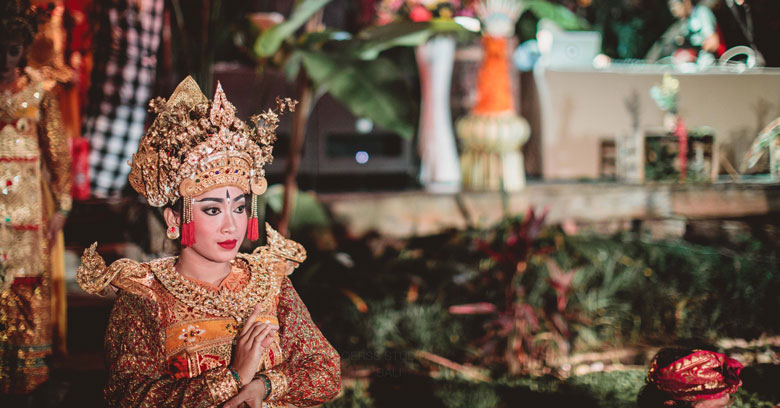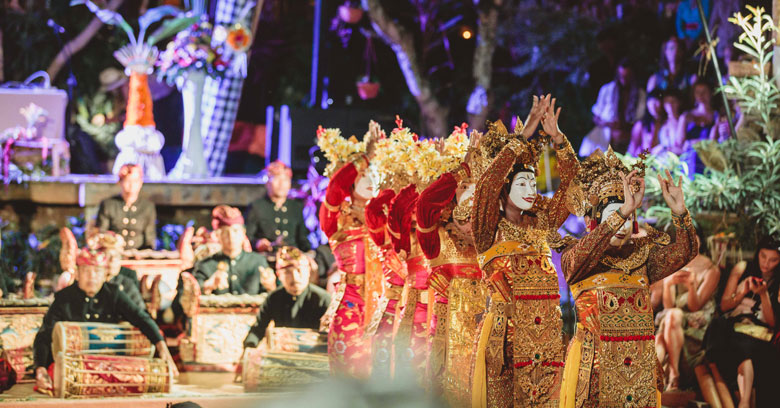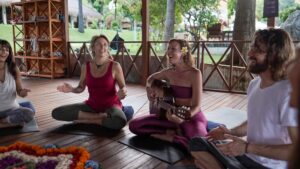
As most visitors to the island of Bali can profess they are keen to learn a little about Balinese Dance in a sideways glance. Visitors listen with one ear cocked taking in an explanation of the history of the dance form whilst swiping the eyes left to right so as not to miss the detailed performance in motion. There is so much to take in whether it be the synchronicity of floating fingers and lifted toes, the provocative eye movements of each character or the intuitive speed of the hammer striking the orchestral Gamelans, it is all so captivating. And even more fun to learn, which is easy if you make the community Balinese Dance class at The Yoga Barn with Putu Evie every Monday night.
Balinese culture through dance is as much about history as it is fun and quirky to the viewer. The sideways glance is a perfected art form and this ‘sladek’ sideways eye movement is your opportunity to practice one of the key characteristics of the Pre Legong Era styles of this tradition, it quite literally means you are observing keenly whilst not being obvious to the outside observer. It’s about taking something in at a quick and intentional glance.
International Recognition
As the oldest and most celebrated form of movement in Bali it has a proud history. Like most indigenous art forms it has characteristics of cultural significance that identify performances as iconically Balinese. The defining factors are the music, angular movements, traditional costumes and stage arrangements. The better-known elements of traditional dance on the island of Bali are the dress, make-up and adornments of the performers wearing elaborate batik and printed sarongs and fabric, character headwear, performance make-up and bare feet. Typically the body movements are angular, its sideways eye movements (sladeks) are engaging, and the toes are featured with raised and heightened positions. All of these components interplay between the balance of right (kenan) and kiri (left) dance composition. In a more formal sense there are three genres of traditional dance in Bali and they have been internationally recognised in three genres called Wali (sacred dances), Bebali (semi-sacred dances) and Balih-balihan (dances for entertainment purposes).
As a form of entertainment for local communities and visiting international tourists to Bali it has and continues to play an important role animating and emotionally engaging audiences with the religious mythical teachings of the Hindu Gods and retelling of Balinese history. Equally dances are performed throughout Bali during special events, ceremonies, and anniversaries to honour the gods and to ward off evil spirits through specific dance rituals.

Different Styles
There are a few iconic dance styles, the Legong Era of dance seeded in the traditions of the royal courts were afforded by the Royal families for storytelling and ceremonious occasion. These are very ornate experiences with full orchestral music, costume and choreography. Traditional Kecak is a more trance like group performance where the human voice, uprising of energy and movement takes rhythmic sound and dance to another level. Typically men, the troupes wear only black, white, grey and red loincloths with drama characters roleplaying in full theatrical costumes.
Pre Legong Era
Aesthetically the pre Legong Era and adapted post Legong style of Balinese Dance is beautiful with its captivating costumes, make-up and fine expressive movements. Setting the tone and pace of performances are the orchestras of traditional gamelan, gong, Balinese flute and drum instruments. It is the unique sound of the Balinese orchestral music that excites the mythological dance characters into life with haunting beauty and dramatic scenes. If staying in Ubud you may hear the echoes of the gamelan instrument floating in the distance at night as men gather to practice in the village temple’s or shalas.
The islands rich history represents the Royal Kingdoms that ruled it telling tales of palace life. All performances are represented in equal proportion where all dance sequences are choreographed to the right (kenan) and left (kiri) and balanced with central movements in between. This represents the beliefs of the Hindu Balinese who honour through ritual the dark, the light and the in between of this life. Postural alignment and expression also assist the audience to identify the main characters in the story with feminine and male dominant hand positions, shoulder stance, raised arms and agum (poise).
For the most novice audience members both styles of performance are a spectacle to behold. The Legong Era style dancers are adorned with fabulous gold laden fabrics, head wear and painted make-up and masks. With mythological legends, demons and gods animated with swords, fur, masks and jewels. The iconic stone carvings of Balinese architecture stages the back drop and doorframes, it is here performers enter and exit with meticulous precision. The orchestra are at one with the dancers framing the stage to the right and left integrating sound with movement. The traditional artform connects the performers, musicians and the audience intimately resulting in high impact.
Kecak Dance
The Kecak style, where there are no instruments relies on the energy and capability of the human voice, a collaboration of sound from the dancers that course through the bodies of the performers enliving their more organic, body slapping tribal movements. These outdoor experiences relate to where dancers end up in a more enthused trance like state raising their resistance and strength of mind, body and spirit. These dances are done to the backdrop of sound and vocal landscapes uplifting performances and exciting audiences with emotional and dramatic storylines.
Where to See a Balinese Dance Performance in Ubud
It only takes a drive from Denpasar to visit Ubud to enjoy a performance of one of many local troupes who perform in the central area on Jalan Raya Ubud, Hanoman Street and Monkey Forest Road. There are a variety of favourite Balinese dances performed everyday at one or another of the local Banjar shala’s and the experience far out weighs the cost. Allow a couple of hours for the overall experience getting in early if you want a front row seat.
Every visitor who experiences a Legong or Kecak leaves with a very real sense of how dance as an art form represents the Hindu culture and is maintaining integral cross generation connections in local communities. Young dancers and youth gamelan performers are guided by more senior members of the troupes and everyone is responsible for entertaining and pulling in the tourist crowds. Ticket sellers on the street around the Ubud Market will seek you out which offers flexibilty in terms of making a spontaneous decision of an evening to grab a ticket if you are eating or already in town.
Learn Balinese Dance in a Sideways Glance at The Yoga Barn
Ubud is the home to The Yoga Barn’s Balinese co-founders and all aspects of the traditional and modern culture breathe through the lives of our staff and local community programs plus influence our programming schedule. One favourite community class is the Balinese Dance class held Monday evenings with Putu Evie, 5:30pm to 6:30pm. A fun and fascinating class it challenges both our male and female guests in a very light hearted way, putting traditional dance theory is into immediate practice.
You will learn the basic poses, angular movements, stance, rhythm and timing of the Pre Legong Era dance, including cheeky facial expressions, eye movements and hand gestures. Believe it or not after 1 hour you will peform what you have learnt as a group and leave feeling more connected with the island of Bali as a result of this experience. Newfound appreciation of the arts goes a long way in a travel experience!.
Ubud Based International Performing Teacher
Putu Evie lives in Ubud and is an international teacher and performer of Pre Legong Balinese Dance who has performed in troupes across Indonesia and around the world. A pure delight she is the talent behind how traditional Bali dance can be taught in a sideways glance. Her classes are refreshing and surprisingly special. She embodies all that is culturally rich about Bali teaching the importance of mindfulness and precision.
If you are in Ubud and wanting to learn about the people, history, and cultural importance of dance as a tradition then this is an class for you. To confirm the day and time of the class on our weekly class schedule check Balinese Dance on our downloadable monthly schedule or download our APP.
So enjoy your class, and let us know how you went learning Balinese Dance at a glance!



